Magento 2 Heterogeneity: Open Source vs. Commerce vs. Commerce Cloud

Magento has become the number one e-commerce platform for thousands of merchants all over the world. Its excellent popularity is a result of the outstanding flexibility, which is represented by numerous traits and different editions that deliver diverse feature sets. Open Source, Commerce, and Commerce Cloud introduce distinct e-commerce conditions aimed at businesses of all sizes and niches. In the following material, we compare the three editions side by side to understand the core differences between them. Let’s see what unique opportunities Magento 2 Open Source, Magento 2 Commerce, and Magento 2 Commerce Cloud offer.

Table of contents
- 1 Brief Overview
- 2 Magento 2 Open Source vs. Commerce
- 2.1 Elastic Search
- 2.2 B2B Module
- 2.3 Page Builder
- 2.4 Advanced Marketing Tools
- 2.5 Advanced Category Management
- 2.6 Content Staging
- 2.7 Unique Content Elements
- 2.8 Visual Merchandiser
- 2.9 Archive
- 2.10 Google Tag Manager
- 2.11 Scheduled Import/Export
- 2.12 Integration with ERP Systems
- 2.13 Customer Attributes
- 2.14 Advanced Shopping Assistance
- 2.15 24/7 Support
- 3 Magento Commerce Cloud vs. Magento Commerce
- 4 Magento 2 Open Source vs. Commerce vs. Commerce Cloud
Brief Overview
Below, we shed light upon the nature of each edition to provide a basic understanding of Magento 2 Open Source, Commerce, and Commerce Cloud.
Magento 2 Open Source
Back in 2008, the e-commerce universe reached its tipping point: Magento Community was born. Lately known as Magento 2 Open Source, it forever changed the e-commerce dimension by providing a robust and, at the same time, free software solution for running a retail business online. More than ten years passed, and now we have a feature-rich platform with a massive community around it. It still lacks some instruments associated with its commercial cousin, but you can quickly get almost all of them as third-party extensions.
Although Magento 2 Open Source is aimed at the basic needs of online retailers, it goes far beyond the minimal stack of instruments. This version is enough for launchings a fully-functional e-commerce website. And if your business requires any additional enhancements, feel free to visit the Magento Marketplace – you will discover all the necessary tools there.
Besides, Magento 2 Open Source lets you apply any configuration modifications to the platform. There are enough experienced developers and reliable agencies that can help you with any customizations. As a result, you can create an engaging e-commerce experience without hassle using the Open Source edition of Magento 2.
The platform’s outstanding flexibility makes it suitable for a wide range of projects from the most minimalist local retail solutions to the high-demanding industry leaders. For instance, this excellent incorporates Magento Open Source. 
However, you can create a far more modest storefront with much less effort. Considering such opportunities, one may wonder why does Magento Commerce exist at all? We provide several convincing arguments below.
Magento 2 Commerce
Formerly known as Magento Enterprise Edition, Magento Commerce is often considered as a paid version of Open Source on steroids. It delivers a bunch of advanced features and functionalities that are neither available in the free edition by default nor via third-party extensions (e.g., Page Builder or Content Staging). However, Magento 2 Commerce is not for everyone. The platform is associated not only with advanced peculiarities and unlimited access to customizations but also with a high price tag. The latter makes enterprise-level businesses its primary target.
The gap between the two editions has broadened significantly within the last few years. For instance, Magento Commerce introduced a B2B module that turned it into a robust wholesale platform. However, the ecosystem offers enough third-party solutions to deliver even better B2B experiences on Open Source.
Other unique advantages, such as Page Builder, Content Staging, and Visual Merchandiser, took the usability of Commerce Edition to a whole new level. Now, Magento administrators can accomplish chores faster and more efficiently. Nothing similar is available through third-party solutions.
An advanced level of personalization is another distinctive feature of Magento 2 Commerce. It delivers individual product recommendations powered by Adobe Sensei’s artificial intelligence. Although Magento 2 Open Source lacks this feature, you can connect it to even more powerful alternatives.
All these and numerous other traits are available at $24,000 annually. Note that the pricing system of the edition incorporates a tiered model linked to gross merchandise value: The more you sell – the more you pay.
Check this O’Neills since it is a perfect example of a Magento Commerce store with rapid dynamic search and impressive personalization functionality. Ireland’s largest sportswear manufacturing company was generous with its investments in a shopping journey it delivers.

Although it seems that Magento 2 can satisfy any demand with its free but extremely flexible and reliable Open Source and obtain even more beneficial results with Commerce, there is one more edition: let’s see why Commerce Cloud ever lasts.
Magento Commerce Cloud
If Magento Commerce is Open Source on steroids, Commerce Cloud introduces an even more sophisticated offer with all the bells and whistles of the other two editions. It delivers all Magento Commerce features through the cloud infrastructure, incorporating Amazon Web Services (AWS). Besides, the platform adds some unique options to the feature list that we discuss below.
Commerce Cloud is developed to address the most complicated e-commerce tasks. And the ability to cope with all possible difficulties costs a lot. The pricing model of Magento Commerce Cloud is based on tiers and ranges between $40,000 and $300,000 per year. Thus, only top market players can afford this platform’s version. For instance, utilizes Magento Commerce Cloud to maintain a complex, global website that consists of 30 stores and supports 6 languages. Back in 2016, this was one of the most significant Magento Cloud projects, if not the leader of the entire ecosystem at all.

However, a wave of criticism is stacked against Magento Commerce Cloud. You can discover some concerns regarding the platform’s performance here: . Besides, several Reddit discussions unveil such issues as slow support, limited scaling capabilities, extended downtime, lack of elasticity, and numerous hosting challenges. Check them here:
- ;
- ;
- .
Now, when you are familiar with the core differences between Magento 2 Open Source, Magento 2 Commerce, and Magento 2 Commerce Cloud, let’s compare them side by side.
Magento 2 Open Source vs. Commerce
As we’ve already mentioned above, Magento 2 Commerce shares a lot of features with Open Source. Below, you can see a list of core functions that the two editions come with:
- Various catalog management tools and features;
- Numerous product management capabilities;
- Standard marketing, promotion, and conversion tools;
- Customer accounts;
- Checkout with integrated payment and shipping options;
- Instant purchase checkout capabilities;
- Advanced Reporting powered by Magento Business Intelligence;
- Standard analytics and reporting;
- Various performance improvements, including Full Page Cache;
- dotmailer marketing automation.
Also, note that both structures rely on the same open-source technologies:
- Web servers: Apache or Nginx;
- PHP: Composer with dependency management package for PHP;
- Database: MySQL and MySQL Percona;
- HTTP accelerator: Varnish;
- Cache Storage: Redis;
- Search: Elasticsearch;
- Additional technologies: HTML5, CSS3 with LESS preprocessor, jQuery as a primary JavaScript library, RequireJS to load JS resources on-demand, Knockout.js to simplify JS UIs with the MVVM pattern, miscellaneous third-party libraries (Zend Framework, Laminas, Symfony, etc.), and various coding standards (PSR-0, PSR-1, PSR-2, PSR-3, PSR-4);
- Optional stack components: Varnish, Redis, Elasticsearch, RabbitMQ;
- Automated testing: unit, integration, functional and performance test scripts; JavaScript tests; tools for static code analysis, etc.
Now, let’s focus on the unique characteristics of Magento Commerce.
Elastic Search
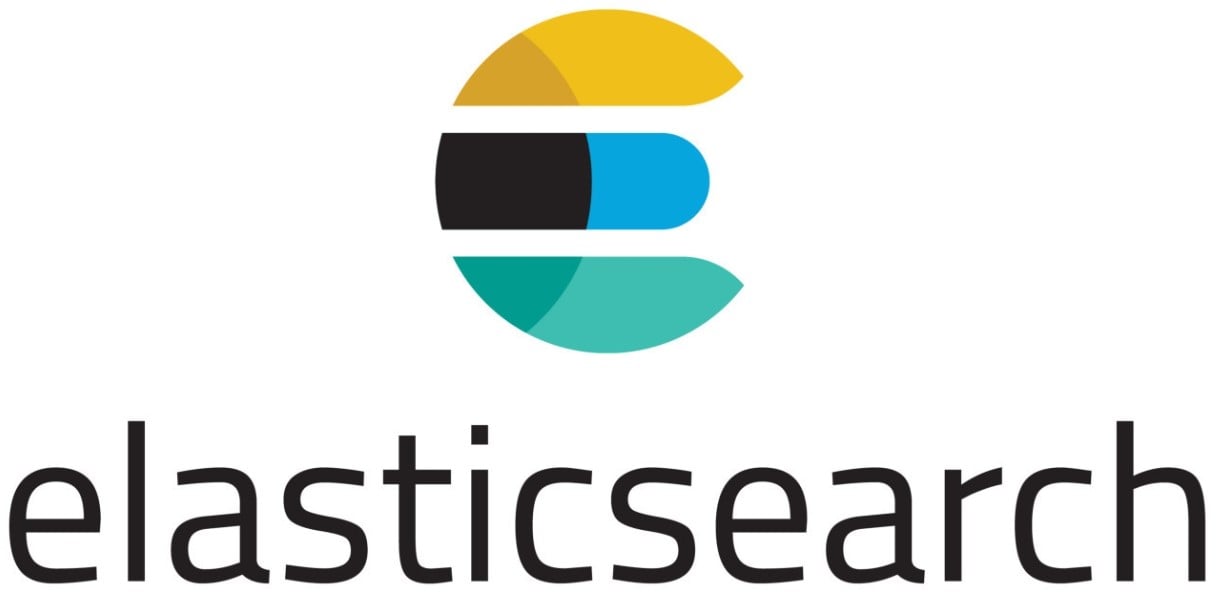
Although Elasticsearch was a hallmark of Magento 2 Commerce, it has recently become a part of Open Source. Thus, both editions allow smooth search requests through large catalogs out of the box no matter what language is used. Real-time data, suggestions, autocorrections, stop words, synonyms, and numerous other features make it easier for store visitors to dig up what they are looking for.
B2B Module
The Magento 2 B2B module is one of the most notable enhancements of Commerce in comparison to Open Source. It is developed to address the needs of wholesale merchants and companies aimed at other businesses. The B2B module allows implementing complex organizational hierarchies with different permission levels. Besides, it offers personal catalogs, quotes, and negotiations. As a Magento 2 Commerce merchant, you can leverage the following B2B functionalities:
- Negotiable Quote: this tool enables negotiable quotes in a Magento 2 B2B environment: a buyer and a seller can negotiate product and shipping prices before placing an order;
- Requisition List: as for this feature, it enables requisition lists in a Magento 2 B2B environment: a buyer can create multiple rosters of frequently-purchased products to use them for rapid order placement;
- Shared Catalog: it enables shared catalogs in a Magento 2 B2B environment: visibility and different prices for products and B2B quotes for various companies;
- Company Accounts: this instrument allows sellers to create company accounts with varying roles of permission and assign multiple members to them;
- Company Credit: it enables the Payment on Account payment method for B2B companies – an offline way to allow companies to make purchases up to the specified credit limit;
- Company Payment: the feature lets sellers configure which payment methods to allow for B2B companies;
- Quick Order: it provides buyers with the ability to create new orders from a list of multiple SKUs.

Although the B2B module has been one of the significant functional enhancements for Magento within the last few years, there always were reliable third-party extensions that offer the same or even better features. You can find a list of third-party B2B tools for Magento 2 here: Magento 2 Business-to-Business (B2B) extensions and solutions.
Page Builder
Page Builder is another enhancement introduced in Magento 2 Commerce. It is a Magento extension for creating content in the most user-friendly manner – by dragging-and-dropping page elements. The tool offers a system of pre-built controls called “content types” that are displayed through the Page Builder’s menu via four categories:
- Layout;
- Elements;
- Media;
- Add Content.
The tool lets you apply drag-and-drop functionality for content creation as well as see live previews of how everything looks on the storefront. Besides, form editors are under your disposal. They let you customize the content in a more admin-friendly way.
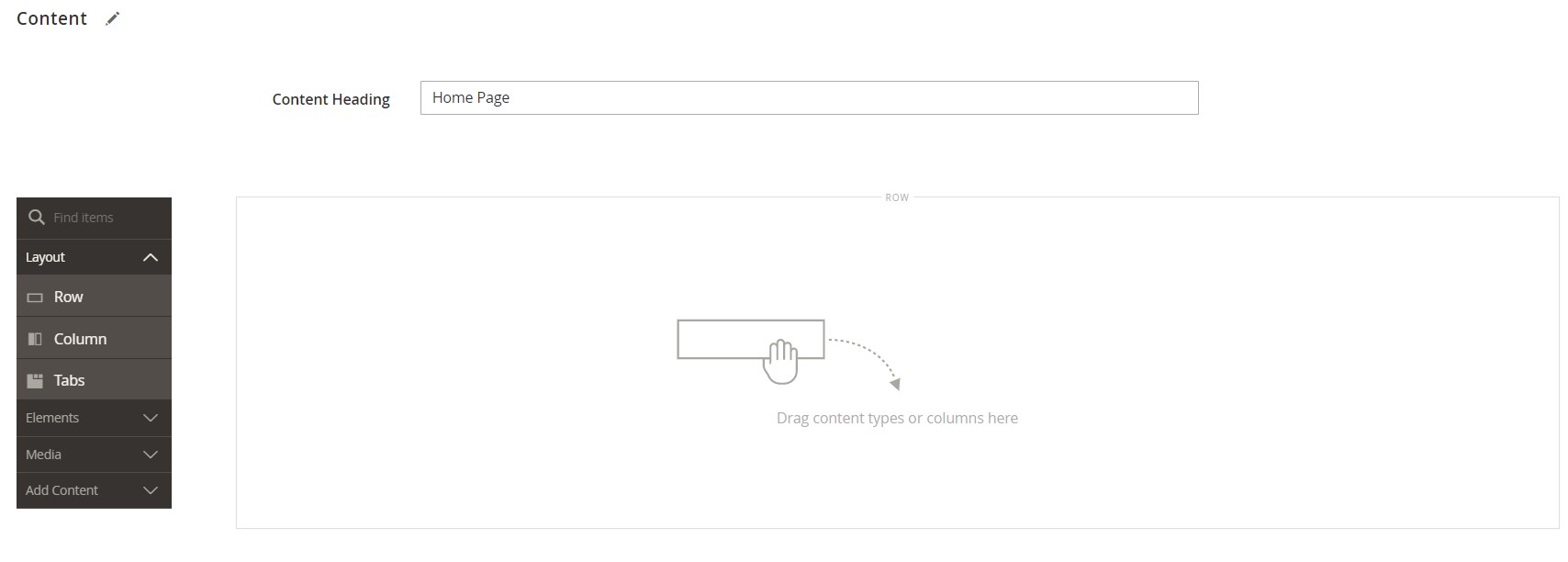
Perhaps, the most significant benefit of Page Builder is that it requires no coding to apply changes to the appearance of the frontend. As a store administrator, you can either extend existing content types or create new ones within just a few clicks. You can check the official Page Builder guide here:
Advanced Marketing Tools
Magento 2 Commerce provides lots of tools developed to engage store visitors, turning them into buyers. The commercial edition introduces several vital marketing enhancements which, in their turn, are available to the users of Open Source with third-party plugins. Magento Commerce offers means such as:
- Customer segmentation: you can divide clients into groups way more precise than it is possible in the Open Source edition. Magento 2 Commerce provides the ability to create segments based on various data customers offer in their accounts: year of birth, gender, address, etc.
- Emails reminders: if a store visitor exits your website, leaving a full cart, Magento Commerce provides the ability to turn them back with the help of an email message that delivers a discount and a user-friendly cart recovery process.
- Gift registry: your customers can create gift registries for special occasions right from their dashboard, adding products they want to be gifted with. Next, they invite their friends and family to purchase the items from the registry. As a store administrator, you get the ability to control all the acquired goods, including their remaining quantities.
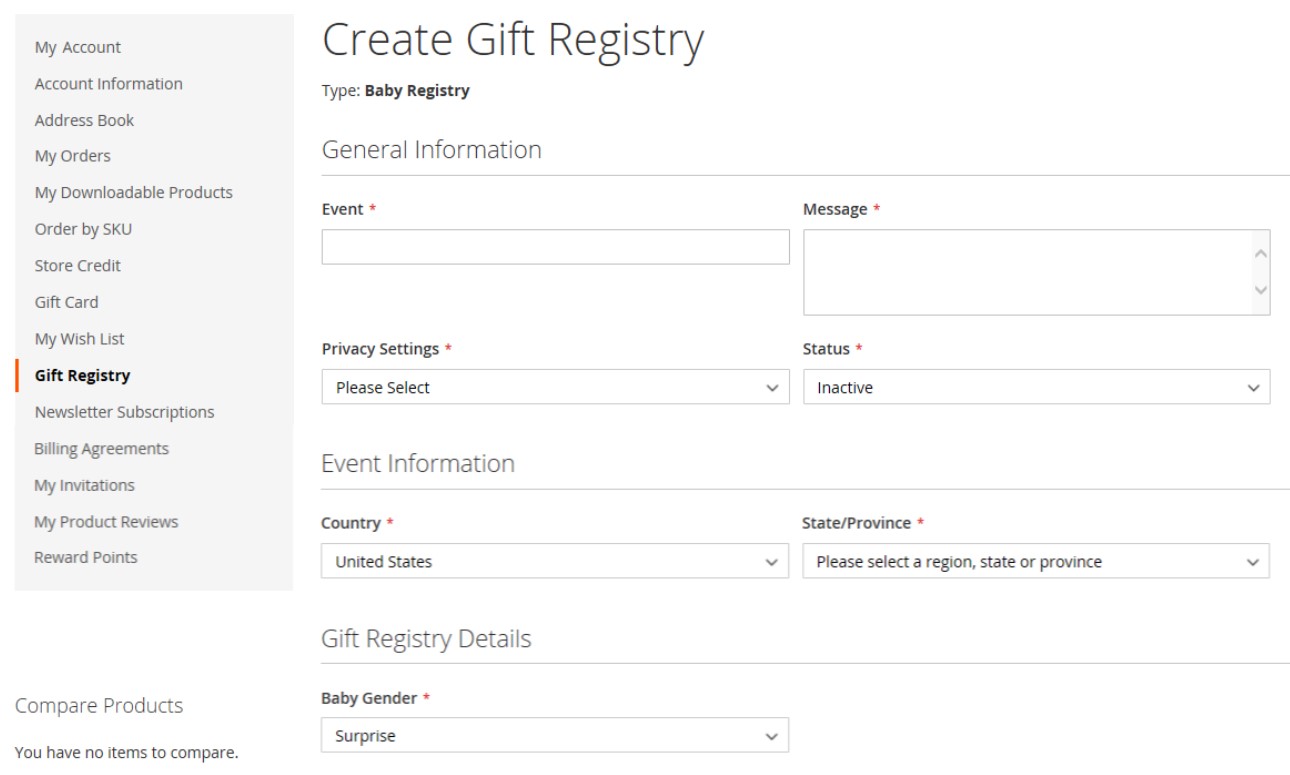
- Gift cards: Magento 2 Commerce offers three kinds of gift card products. Firstly, you can leverage virtual ones by sending them to customers by email. Secondly, physical gift cards are under your disposal. They can be shipped to the recipient from a post office. Thirdly, these two types can be combined.
- Private sales and events: this feature lets you generate buzz and new leads as well as offload surplus inventory, using your existing customer base. With Magento 2 Commerce, it is possible to configure limited-time sales visible to specific members or even generate a standalone private sale page. Next, you can invite customers and share event details with them, providing the VIP treatment to the members of a closed group.
- Rewards points: with Magento’s reward points system, you get another instrument for driving customer engagement and promoting customer loyalty. The platform lets you award customers with points for a wide range of transactions and activities. You can manage the point distribution, keep track of their balance, and control the expiration. Besides, it is possible to set the conversion rate between reward marks and currency. Customers can redeem points on the checkout, purchasing goods and services.
- Returns and exchanges: a returned merchandise authorization, or shortly RMA, is a system that simplifies the life of both admins and shoppers. If customers request to return an item for replacement or refund, the corresponding Magento 2 Commerce feature lets you address the problem within a few clicks. As an administrator, you can enable RMA for either all products or specific items.
- Store credit: this feature is tightly connected to the one mentioned above. As a Magento 2 Commerce administrator, you can use the store credit for cash refunds, while customers can leverage this functionality to pay for purchases. Besides, a gift card balance can be turned into store credit to eliminate the use of gift card codes.
- Product recommendations: it is another powerful tool that is exclusively available for Magento Commerce users. Product recommendations provide the ability to implement individual approaches to customers, increasing conversions, boosting revenue, and stimulating shopper engagement. Powered by artificial intelligence and machine-learning algorithms of Adobe Sensei, this tool performs an in-depth analysis of aggregated visitor data to provide every prospect with highly personalized experiences.
- Related product rules: this feature represents a more conventional approach to product recommendations. As a store administrator, you get the ability to target the selection of products that are presented as related products, up-sells, and cross-sells instead of creating every relation manually. However, a slight touch of personalization is possible since you can associate each product rule with a customer segment.
Advanced Category Management
Although Open Source and Commerce editions share lots of standard features when it comes to category management, there are two exclusive instruments that users of the latter can leverage.
First of all, it is a Content Staging-based feature that enables scheduled changes. It lets store administrators apply category updates grouped with other content changes following a planned date.
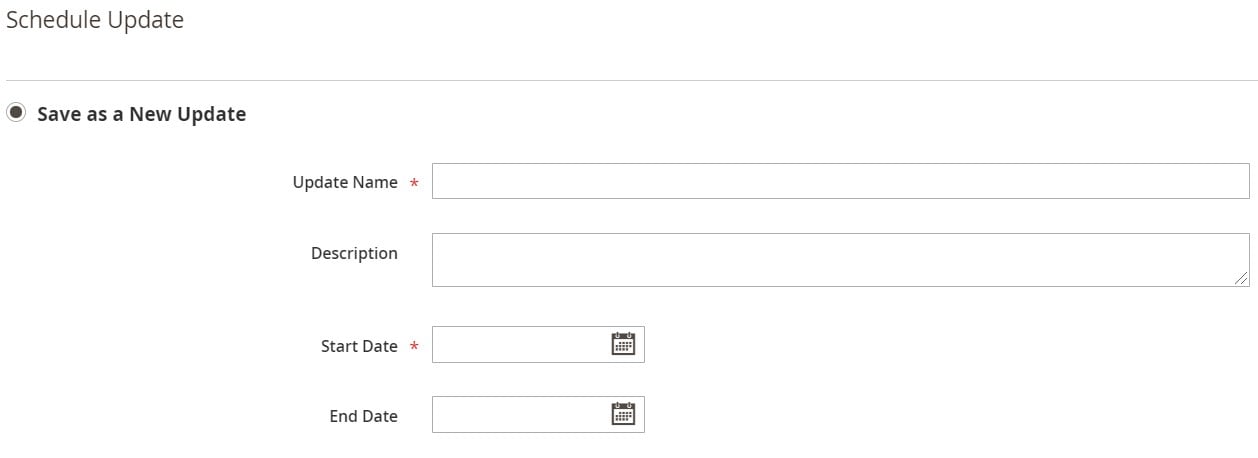
Secondly, Magento 2 Commerce enables category permissions. It means that you can restrict category access to specific customer groups. The platform provides the ability to control the display of product prices as well as choose customer groups that are allowed to add products to the cart.
Content Staging
Now, let’s say a few more words about the Content Staging functionality mentioned above. Magento 2 Commerce allows its users to create, preview, and schedule a wide range of content updates. With the Content Staging tool, every static page turns into a collection of different elements that can be enabled or disabled. Changes are applied automatically according to a campaign which, in its turn, is a record of scheduled alterations available for preview and management.

Content Staging provides the ability to create scheduled updates for products, categories, catalog and cart price rules, CMS pages and blocks, and widgets.
Unique Content Elements
Magento 2 Commerce delivers several content types unavailable in Open Source. They include page hierarchy, dynamic blocks, and banners (replaced in recent versions).
The store’s page hierarchy system adds additional management capabilities in terms of content organization and optimization. The tool lets you attach pagination, navigation, and menus to simplify the browsing experience. Leverage page hierarchy to display your content in such an order that people can easily find the materials they need.

As for dynamic blocks, they provide the ability to create rich, interactive content that incorporates price rules and customer segment data. Since the feature is integrated with Page Builder, you can manage existing dynamic blocks right there.

Although banners are replaced in the advanced content tools, they are still available for those merchants whose stores cannot use Page Builder. You can rely on this content type to display an image or block of content as a part of a promotion that appears for a specific period. Magento Commerce supports targeted banners visible to specified customer segments. Besides, their display can be controlled by price rule conditions and coupon use.
Visual Merchandiser
With Visual Merchandiser, Magento 2 Commerce users receive a set of tools that enable product positioning following conditions that determine product appearance in the category listing. In other words, you can organize the product display order in a matter of a few clicks. The feature’s visual mode displays each product as a tile on a grid where you can manage its order. Alternatively, it is possible to arrange everything in a list of products right in the category. As for Open Source, you have to visit a category section and set priority numbers to achieve similar results.

Archive
Magento 2 Commerce lets you archive orders to improve the performance of your e-commerce website as well as keep your workspace free of unnecessary information. The feature provides the ability to pack invoices, shipments, and credit memos and put them into separate storage. At the same time, you can manage everything manually. Since you don’t delete them, all the hidden elements are available at any time.

Google Tag Manager
Google Tag Manager is another exclusive feature of Magento Commerce. It provides the ability to manage code snippets (tags) related to your marketing campaign events. The tool gives you the ability to add tracking tags that help to measure the audience data, transferring it directly to Google Analytics and other third-party solutions. Consequently, you get a clear picture of how well your Magento Commerce website is performing. Both Google Analytics and Tag Manager accounts are required for using this tool.

Scheduled Import/Export
As we all know, import and export tools of Open Source are frankly limited. However, Magento 2 Commerce partly addresses this issue by introducing scheduled imports and exports. Merchants get the ability to run data transfers on a daily, weekly, or monthly basis. Both your local Magento server and a remote FTP server are supported. You can configure everything using the Cron job scheduler. However, this functionality is far from being as flexible as the one introduced in the Improved Import & Export extension.
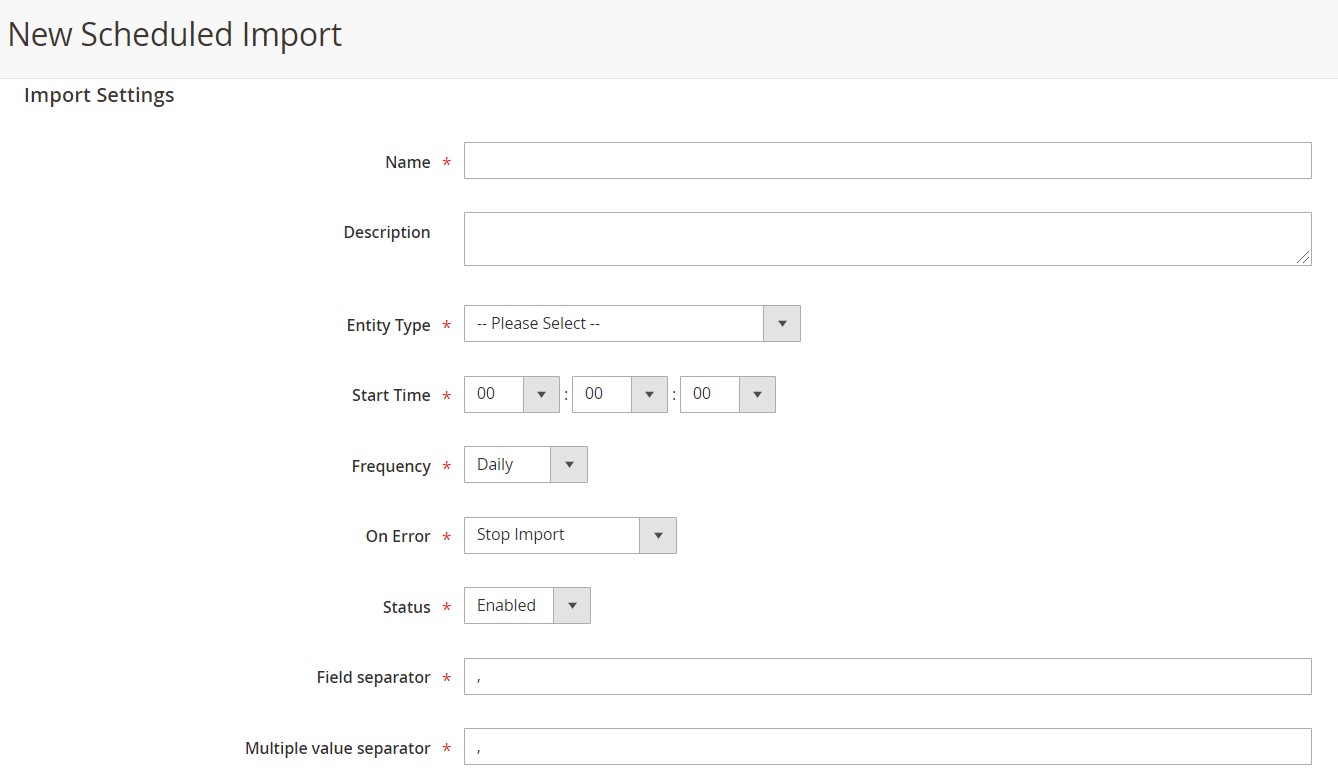
Integration with ERP Systems
B2B users of Magento 2 Commerce can also leverage a flexible API that integrates with a variety of ERP solutions. However, each particular connection is available via a dedicated Magento extension. Check these . Open Source users can achieve the same functionality with even higher flexibility due to Improved Import & Export extension and its add-ons. However, Commerce merchants can leverage the module as well.

Customer Attributes
Another essential enhancement of Magento Commerce is the ability to extend customer attributes with custom fields. Thus, you get the ability to collect/provide information required for order, fulfillment, and customer management processes.
Magento 2 Commerce provides the facility to add custom attributes to the following sections of a customer’s account: Account Information, Address Book, and Billing Information. At the same time, you can utilize customer address attributes in the Billing Information section during checkout or account registration.
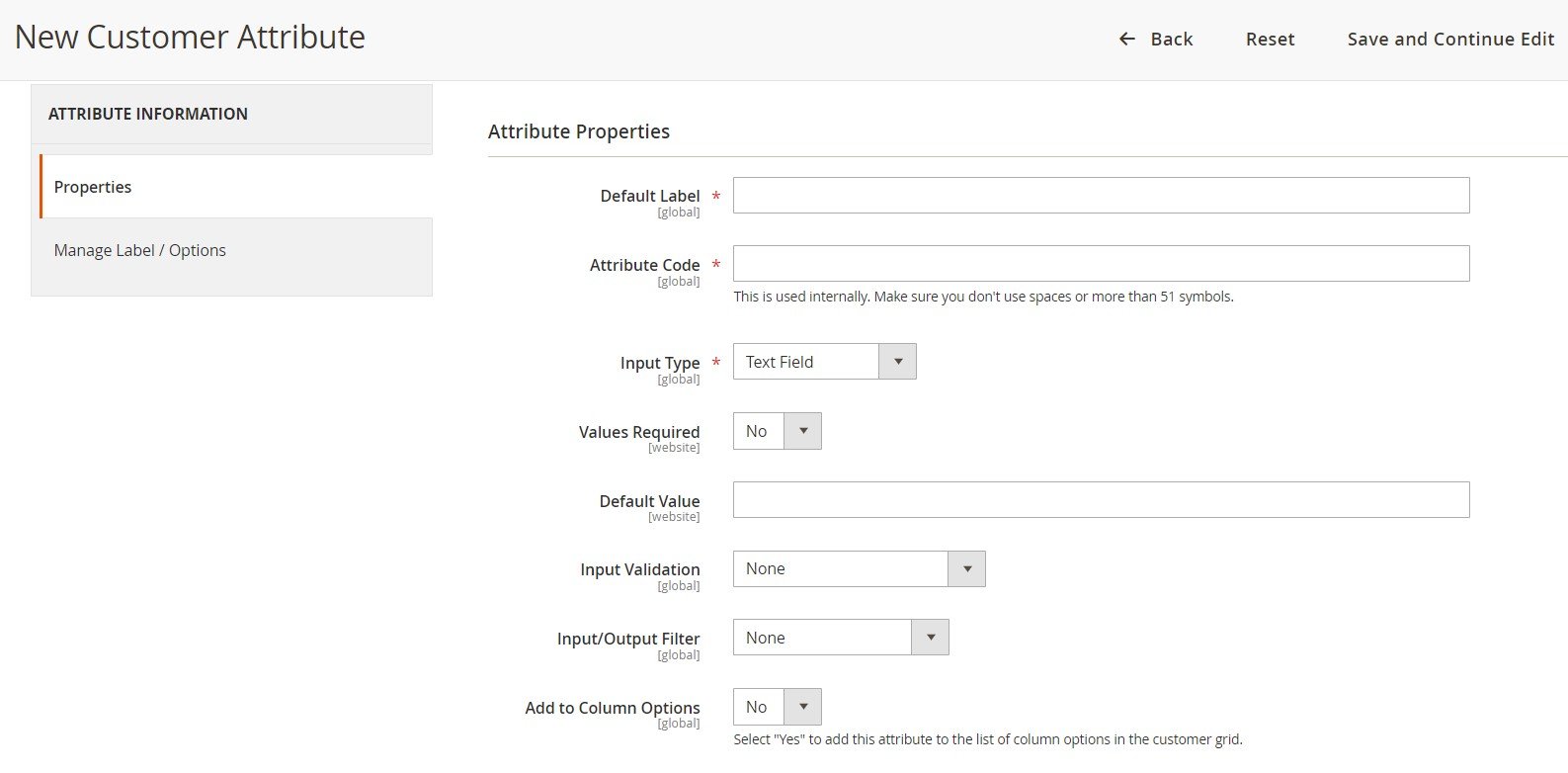
Advanced Shopping Assistance
There are situations when customers cannot complete a purchase without assistance. Although both Open Source and Commerce editions of Magento 2 let you help your prospects, the latter provides extended capabilities for logged-in customers in a shopping cart area. As an administrator of a Magento 2 Commerce website, you can add products to the cart from the store’s backend. Thus the platform increases chances that goods are bought, reducing cart abandonment.
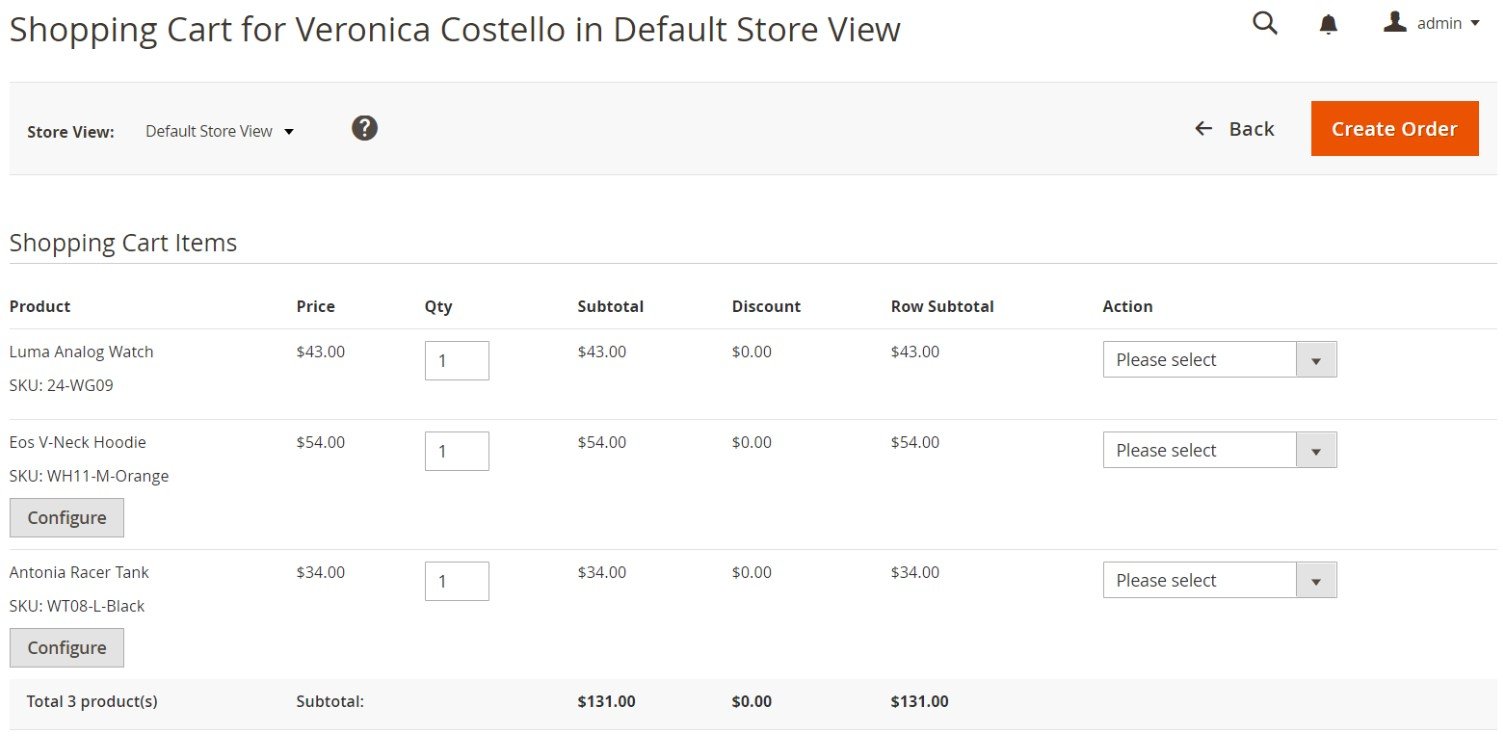
24/7 Support
Magento Commerce offers 24/7 customer support, which is crucial for resolving some technical issues. At the same time, a dedicated account manager is assigned to you, redirecting to valuable resources. Besides, you can leverage a customer success manager – a specialist focussed on maximizing the potential of your Magento storefront.
As for the Open Source edition, it lacks Magento-provided support. Since you are left alone with self-support options, addressing technical issues falls on your shoulders. However, there are lots of community forums, agencies, and specialists who can help you.
Besides, Magento 2 Open Source lacks copyright infringement protection. It means that you are solely responsible for defending against claims related to Magento’s core software.
Magento Commerce Cloud vs. Magento Commerce
While Magento Commerce lets you run a store on-premise, you can also choose a cloud option that contains all its features and introduces several additional benefits. Meet the Magento Commerce Cloud edition – a robust PaaS solution that runs on Amazon Web Services, providing merchants with managed service infrastructure, better performance, enhanced security, and top-notch scalability. The edition comes up with numerous supplementary technologies, including Fastly, Blackfire, New Relic, etc. They substantially simplify the deployment process in comparison to Magento 2 Commerce. The following core benefits of Commerce Cloud are under your disposal:
- AWS hosting. One of the most significant aspects of the edition is its cloud nature. Commerce Cloud introduces an environment to run an e-commerce business smoothly. A dedicated development team guarantees your online store is operating with maximum efficiency. Even the most essential traffic spikes won’t hit its performance and availability.
- Git-based workflow. With the GitHub integration, you can manage your Magento Commerce Cloud environments right from the GitHub repository. Besides, it is possible to configure your Bitbucket or GitLab repository to build and deploy an environment while pushing code changes automatically.
- Performance tools. Commerce Cloud offers an associated with advanced scalability for deployment. You can leverage a set of scripts and accessories to simplify numerous chores, including cron management, project verification, docker deploy environment, etc. Various other performance improvements of Commerce Cloud are under your disposal out-of-the-box.
- Fastly integration. To optimize and secure content delivery, Magento Commerce Cloud streamlines numerous Fastly services. Firstly, it is a Varnish-based CDN that caches your site to achieve a faster page load. Secondly, multiple security options are under your disposal, including built-in DDoS protection and Web Application Firewall. Thirdly, Magento Commerce Cloud delivers several image optimization techniques that positively impact the performance of your e-commerce project.
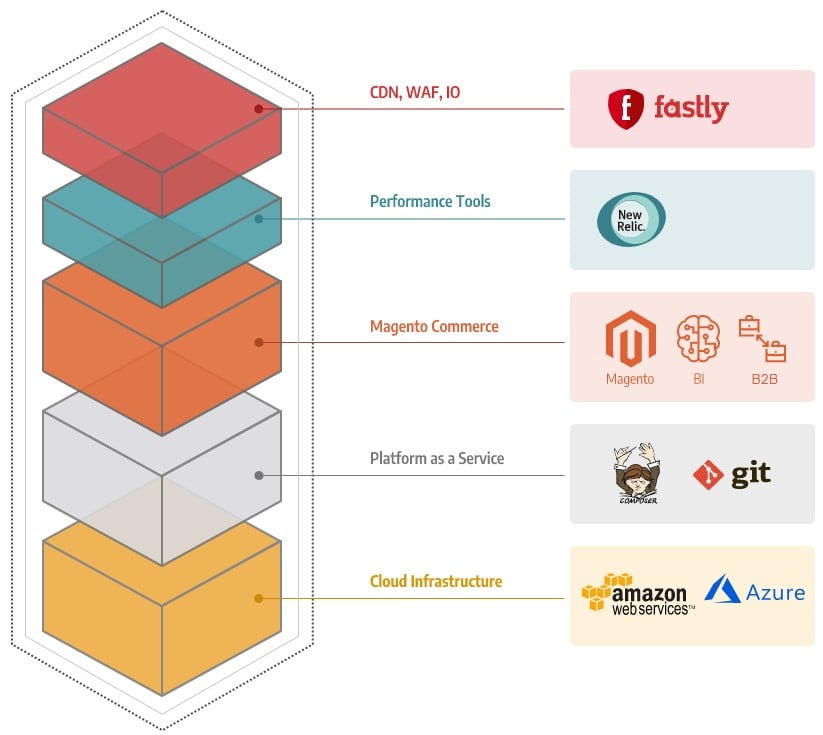
Magento 2 Open Source vs. Commerce vs. Commerce Cloud
So, let’s aggregate all the data we have into a table to show the difference between the three editions of Magento 2. Below, you will also find links to extensions that add the missing functionality to Magento 2 Open Source.
| Open Source | Commerce | Commerce Cloud | |
| Product Management | ✓ | ✓ | ✓ |
| Product Types: | ✓ | ✓ | |
| – Simple product | ✓ | ✓ | ✓ |
| – Configurable product | ✓ | ✓ | ✓ |
| – Grouped product | ✓ | ✓ | ✓ |
| – Virtual product | ✓ | ✓ | ✓ |
| – Bundle product | ✓ | ✓ | ✓ |
| – Downloadable product | ✓ | ✓ | ✓ |
| – Gift card | Magento 2 Gift Card Extensions | ✓ | ✓ |
| Advanced Pricing | ✓ | ✓ | ✓ |
| Inventory Management | ✓ | ✓ | ✓ |
| Visual Content: | |||
| – Images | ✓ | ✓ | ✓ |
| – Videos | ✓ | ✓ | ✓ |
| – Swatches | ✓ | ✓ | ✓ |
| Category Management: | |||
| – Standard category management tools | ✓ | ✓ | ✓ |
| – Scheduled changes | ✓ | ✓ | |
| – Permissions | Category Permissions for Magento 2 | ✓ | ✓ |
| Shared Catalogs | – | B2B Module | B2B Module |
| Shopping Tools: | ✓ | ✓ | ✓ |
| – Email a Friend | ✓ | ✓ | ✓ |
| – Wish List | ✓ | ✓ | ✓ |
| – Wish List Search | Multiple Wishlist Extension | ✓ | ✓ |
| – Compare Products | ✓ | ✓ | ✓ |
| – Recently Viewed/Compared | ✓ | ✓ | ✓ |
| Product Reviews | ✓ | ✓ | ✓ |
| Product Relations: | |||
| – Related products | ✓ | ✓ | ✓ |
| – Cross-sells | ✓ | ✓ | ✓ |
| – Up-sells | ✓ | ✓ | ✓ |
| Promotions: | |||
| – Catalog Price Rules | ✓ | ✓ | ✓ |
| – Cart Price Rules | ✓ | ✓ | ✓ |
| – Related Product Rules | Related Products for Magento 2 | ✓ | ✓ |
| – Product Recommendations | Personalization Services for Magento 2 | ✓ | ✓ |
| Merchandising: | ✓ | ✓ | |
| – Visual Merchandiser | – | ✓ | ✓ |
| – Gift Registry | Magento 2 Gift Registry Extensions | ✓ | ✓ |
| – Rewards and Loyalty | Magento 2 Reward Points Extensions | ✓ | ✓ |
| – Private Sales and Events | Private Sales & Flash Sales | ✓ | ✓ |
| Communications: | |||
| – Standard emails | ✓ | ✓ | ✓ |
| – Email reminders | Email Reminders for Magento 2 & Follow Up Email Extensions |
✓ | ✓ |
| – dotdigital Engagement Cloud | ✓ | ✓ | ✓ |
| – Sales documents | ✓ | ✓ | ✓ |
| – Newsletter | ✓ | ✓ | ✓ |
| – RSS feed | ✓ | ✓ | ✓ |
| – Variables | ✓ | ✓ | ✓ |
| Navigation & Search: | |||
| – Layered Navigation | ✓ | ✓ | ✓ |
| – Breadcrumbs | ✓ | ✓ | ✓ |
| – Catalog Search | ✓ | ✓ | ✓ |
| – Search Terms | ✓ | ✓ | ✓ |
| – Search Synonyms | ✓ | ✓ | ✓ |
| SEO: | |||
| – Meta Data | ✓ | ✓ | ✓ |
| – Sitemap | ✓ | ✓ | ✓ |
| – URL Rewrites | ✓ | ✓ | ✓ |
| Google Tools: | |||
| – Privacy Settings | ✓ | ✓ | ✓ |
| – Analytics | ✓ | ✓ | ✓ |
| – Content Experiments | ✓ | ✓ | ✓ |
| – Tag Manager | – | ✓ | ✓ |
| – Adwords | ✓ | ✓ | ✓ |
| Point of Purchase | ✓ | ✓ | ✓ |
| – Instant Purchase | ✓ | ✓ | ✓ |
| – Quick Order | – | B2B Module | B2B Module |
| – Shopping Cart | ✓ | ✓ | ✓ |
| – Request a Quote | Request A Quote Extensions | B2B Module | B2B Module |
| – Persistent Cart | ✓ | ✓ | ✓ |
| – Shopping Cart Assistance | – | ✓ | ✓ |
| – Creating an Order | ✓ | ✓ | ✓ |
| – Checkout | ✓ | ✓ | ✓ |
| Order Management | |||
| – Orders | ✓ | ✓ | ✓ |
| – Invoices | ✓ | ✓ | ✓ |
| – Shipments | ✓ | ✓ | ✓ |
| – Dispatches | ✓ | ✓ | ✓ |
| – Batches | ✓ | ✓ | ✓ |
| – Credit Memos | ✓ | ✓ | ✓ |
| – Store Credit | Magento 2 Store Credit Extensions | ✓ | ✓ |
| – Company Credit | Company Credit Magento 2 Extension | B2B Module | B2B Module |
| – RMA | ✓ | ✓ | ✓ |
| – Billing Agreements | ✓ | ✓ | ✓ |
| – Archive | Order Archive Magento 2 Extension | ✓ | ✓ |
| Payments | |||
| – Check/Money Order | ✓ | ✓ | ✓ |
| – Cash On Delivery | ✓ | ✓ | ✓ |
| – Payment on Account | – | B2B Module | B2B Module |
| – Bank Transfer | ✓ | ✓ | ✓ |
| – Purchase Order | ✓ | ✓ | ✓ |
| – Zero Subtotal Checkout | ✓ | ✓ | ✓ |
| – PayPal | ✓ | ✓ | ✓ |
| – Braintree | ✓ | ✓ | ✓ |
| – Klarna | ✓ | ✓ | ✓ |
| – Amazon Pay | ✓ | ✓ | ✓ |
| Shipping | |||
| – Free Shipping | ✓ | ✓ | ✓ |
| – Table Rates | ✓ | ✓ | ✓ |
| – Flat Rates | ✓ | ✓ | ✓ |
| – Dimensional Weight | ✓ | ✓ | ✓ |
| – Shipping Labels | ✓ | ✓ | ✓ |
| – Carriers: UPS, USPS, FedEx, DHL | ✓ | ✓ | ✓ |
| Content Elements | |||
| – Pages | ✓ | ✓ | ✓ |
| – Hierarchy | – | ✓ | ✓ |
| – Blocks | ✓ | ✓ | ✓ |
| – Dynamic Blocks | – | ✓ | ✓ |
| – Banners | Magento 2 Banner Slider Extensions | ✓ | ✓ |
| – Widgets | ✓ | ✓ | ✓ |
| Page Builder | – | ✓ | ✓ |
| Design | |||
| – Design Menu | ✓ | ✓ | ✓ |
| – Page Setup | ✓ | ✓ | ✓ |
| – Page Layout | ✓ | ✓ | ✓ |
| – Themes | ✓ | ✓ | ✓ |
| Content Staging | – | ✓ | ✓ |
| Customers | |||
| – Customer Accounts | ✓ | ✓ | ✓ |
| – Company Accounts | – | B2B Module | B2B Module |
| – Customer Groups | ✓ | ✓ | ✓ |
| – Customer Segments | – | ✓ | ✓ |
| Stores | |||
| – Multiple Stores | ✓ | ✓ | ✓ |
| – Multiple Currencies | ✓ | ✓ | ✓ |
| – Multiple Languages | ✓ | ✓ | ✓ |
| – Tax Management | ✓ | ✓ | ✓ |
| – Product Attributes | ✓ | ✓ | ✓ |
| – Customer Attributes | Customer Attributes for Magento 2 | ✓ | ✓ |
| System | |||
| – Import & Export | ✓ | ✓ | ✓ |
| – Scheduled Import & Export | – | ✓ | ✓ |
| – Scheduled Import & Export + Mapping & API | Improved Import & Export | Improved Import & Export | Improved Import & Export |
| – User Roles | ✓ | ✓ | ✓ |
| – Alternate Media Storage | ✓ | ✓ | ✓ |
| Security | |||
| – Security Scan | ✓ | ✓ | ✓ |
| – Admin Security | ✓ | ✓ | ✓ |
| – CAPTCHA | ✓ | ✓ | ✓ |
| – Two-Factor Authentication | ✓ | ✓ | ✓ |
| – Encryption Key | ✓ | ✓ | ✓ |
| – Session Validation | ✓ | ✓ | ✓ |
| – Browser Capabilities Detection | ✓ | ✓ | ✓ |
| Tools | |||
| – Cache Management | ✓ | ✓ | ✓ |
| – Index Management | ✓ | ✓ | ✓ |
| – Backups | ✓ | ✓ | ✓ |
| – Cron | ✓ | ✓ | ✓ |
| – Action Logs | Magento 2 Admin Logger Extensions | ✓ | ✓ |
| – Web Setup Wizard | ✓ | ✓ | ✓ |
| – Support | – | ✓ | ✓ |
| Reports | |||
| – Marketing | ✓ | ✓ | ✓ |
| – Reviews | ✓ | ✓ | ✓ |
| – Sales | ✓ | ✓ | ✓ |
| – Customers | ✓ | ✓ | ✓ |
| – Products | ✓ | ✓ | ✓ |
| – Private Sales | – | ✓ | ✓ |
| – Business Intelligence | ✓ | ✓ | ✓ |
| – Customer Engagement | ✓ | ✓ | ✓ |
| – New Relic | ✓ | ✓ | ✓ |
| AWS Hosting | – | – | ✓ |
| Git-Based Workflow | – | – | ✓ |
| Performance Tools | – | – | ✓ |
| Fastly Integration | – | – | ✓ |
Now, you can see the real gap between different Magento 2 editions. However, it is not as significant as some people think. Due to a well-developed ecosystem, you can quickly get most Magento 2 Commerce features on the Open Source platform.
The choice of a particular edition depends on your budget and plans. As you can see, Magento 2 Open Source is tailored for the needs of small businesses due to its free nature and the advanced extensibility based on a broad spectrum of third-party solutions. In this case, less features lead to more extended opportunities. Since you are not bound to particular instruments, it is possible to create a unique e-commerce toolset that perfectly suits your needs. Even B2B features are available among numerous extensions.
Magento 2 Commerce suits best to B2B businesses, large market players, international companies, complex marketplaces, and more sophisticated e-commerce websites. If you are planning to extend your business, it may also seem preferable.
If you need an all-inclusive e-commerce solution, choose Magento 2 Commerce Cloud. It is as powerful and feature-rich as Commerce but also delivers easy customization, deployment, and maintenance as well as some performance and security benefits. Besides, you don’t need to worry about hosting. The Commerce Cloud can cover all the technical demands of your e-commerce business no matter how complicated it is!









